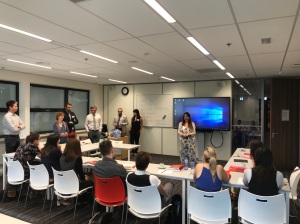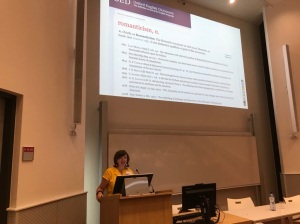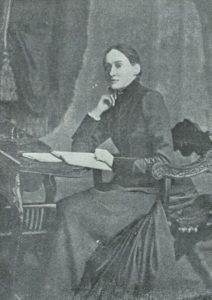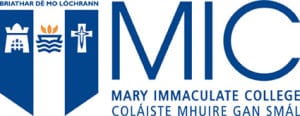IASIL 2018: Reimaging Traditions
Dr Lindsay Janssen

This year’s IASIL (International Association for the Study of Irish Literature) conference, ‘Reimaging Traditions’ was held at Radboud University, Nijmegen (the Netherlands; RU). RU is my alma mater and although I do not work there anymore, I was asked to co-organise the conference. A great opportunity to work together with my former colleagues: Marguérite Corporaal (main organiser), Christopher Cusack, Ruud van den Beuken and Chris Louttit, among others. The conference team also included a life-saving team of student assistants. Although I greatly appreciate their hard work and good company, I am not going to mention everybody involved; this blog post is not my personal Oscar speech. And besides, the full team (and programme) can be found at www.ru.nl/iasil2018/. My apologies if this piece is going to sound bit laudatory: truth be told, of course we had the usual bumps in the road in preparing for the conference, but in contrast to previous ones we organised, this conference itself was relatively stress-free and thus even more enjoyable.
The conference took place from 22 until 27 July and judging by the weather, you would think Radboud has a second campus somewhere in the south of Spain (if only!). The Netherlands had been experiencing exceptionally good weather for about a month and a half, but this specific week it just became ridiculous, reaching temperatures of 37 degrees celsius on the final day. Nevertheless, that did not deter our participants, and we had steady attendance for our panels, keynotes, readings and events.

Our keynotes all gave fascinating and entertaining lectures and made the audience reconsider their preconceived ideas and modes of work. Focusing on the Irish Romanticism, Claire Connolly argued eloquently for reconsidering literary history by focusing on new – well, new to us 21st-century scholars – connections between different cultural figures. Paige Reynolds discussed sex, shame, stereotyping and activism in contemporary literature and theatre and pleaded a strong case for us academics to create a climate of critical openness in our classrooms. I think Reynolds is absolutely right, but do wonder whether our educational institutions, students and their caretakers are ready for this. This does not negate Reynold’s view; rather, it adds force and urgency to her argument. Guy Beiner showed the impressive scope of his knowledge – as always – and looked at the “less-noticeable dynamics of memory” formation and explained how cultural groups also practice “social forgetting”, by focusing on Betsy Gray, a heroine from 1798 who is alive in vernacular history but conspicuously absent from official historiography. (I wish I could say more about his lecture, but was called away on organising business.) Joep Leerssen – I could draw parallels between how Beiner and Leerssen’s brains function – argued for placing more emphasis on the process of reading rather than production when doing literary history. Discussing Irish poets and the Irish bardic tradition, Leerssen made the audience reconsider their set ways while getting regular laughs from the audience in response to his witticisms on freeloading bards and the “hip cool cats” among Ireland’s poets.
As is customary for an IASIL Conference, we had a very broad selection of topics for the panels. That, in preparation at times made assigning titles to the panels a sort of hit and miss process, but during the conference also made possible many interdisciplinary and pleasantly surprising connections. I have been to several IASIL conferences and it strikes me that the IASIL crowd is genuinely open and enthusiastic, and this was the case this year as well. Delegates came from all continents save Antarctica, and spoke on all matters Irish literature, theatre, historiography and art. Moreover, many papers treated transcultural connections and exchanges, tying Ireland and its cultural productions not only to its own diasporic locations, but also to French literature, Persian influences and Asian art, to name a few. I also attended the DH workshop by Suzan Leavey and Cormac O’Brien from UCD, who presented the innovative project ‘Contagion’. On the whole, female authors, poets and artists were well represented in the papers and keynotes, and I could not pass up the opportunity to present on special correspondent, journalist and author Margaret Dixon McDougall, about whom I contributed a blog to the IWWN (‘Tracking “Norah”’). I chaired a few panels and sat in at several papers. I saw many good papers; while giving a rundown of all would make for a long-winded and not particularly interesting blog, I would like to mention a few specifically. Melanie Strating spoke about female Irish migrants who came over to New York because of the great Irish Famine. Strating is new to the field – in fact, her paper was based on her ongoing work for her master’s thesis – but gave a thorough and well thought-out paper in which she innovatively combined literary close readings with economical historical data. Raphaël Ingelbien presented on translator Louise Swanton Belloc, and showed how this fascinating nineteenth-century woman was French, but also self-identified with an Irish Catholic identity. Through an in-depth engagement with her translations and metatextual information – Swanton Belloc intervened in her source texts, at time quite profusely – Ingelbien gave us an original case study of translation, adaptation and cross-cultural identification.

We had a packed cultural schedule as well. The opening reception was combined with the launch of two G. B. Shaw exhibitions, currently on display in the Radboud University Library. Not one but two ambassadors were present at the event – the Irish Ambassadors to Belgium and the Netherlands. Ambassador Kevin Kenny (Ambassador to the Netherlands) opened the exhibition with an engaged speech, and he and his team were kind enough to bring Guinness and Irish whisky. Donning his bartender’s hat for a moment, Ambassador Kenny even gave the catering staff a quick lesson into pouring Guinness. Other conference events consisted of excursions to museums and a city walk, lively readings by authors Anne Enright and Claire Kilroy, a musical performance by Lillis Ó Loaire, a film screening of Song of the Sea (Cartoon Saloon, 2014) and Q&A with filmmaker and co-founder of Cartoon Saloon, Tomm Moore. I had the honour of doing the Q&A with Tomm; being a lover of animation, I just hope that the audience did not tire of my geeky remarks and references. It was wonderful to see how a filmmaker reinvents traditions and provides ways to restore the connections between past and present, humans and their environment, life and legend.
Both organising and presenting at a conference is quite intensive, as many of you will know. In all, it was an inspiring week, well worth its long run-up and last-minute behind the scenes little hiccups. IASIL is always a great event to see old acquaintances and meet new faces, to continue traditions and establish new connections (to make the cheesy but obligatory link to the conference theme). Next year’s event will be at Trinity College Dublin: I look forward to continuing the tradition there.
Dr Lindsay Janssen is affiliated to University College Dublin’s School of English, Drama and Film, where she is working on her two-year project ‘Nodes of Memory: A Study of the Uses of Famine Recollections in Irish Transatlantic Periodical Culture, 1860–1923’. Her research is funded by a Government of Ireland Postdoctoral Fellowship (GOIPD) from the Irish Research Council. She also teaches classes on literature and cultural theory from the nineteenth century until the present at Emerson College’s European Centre (Well, the Netherlands). Her article ‘Diasporic identifications: exile, nostalgia and the Famine past in Irish and Irish North-American popular fiction, 1871–1891’ will be published in Irish Studies Review in 2018.
If you wish to submit a post for our blog contact Dr Deirdre Flynn.



